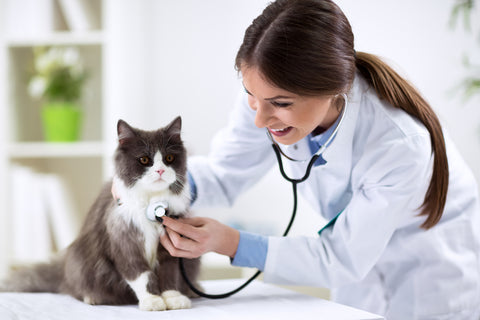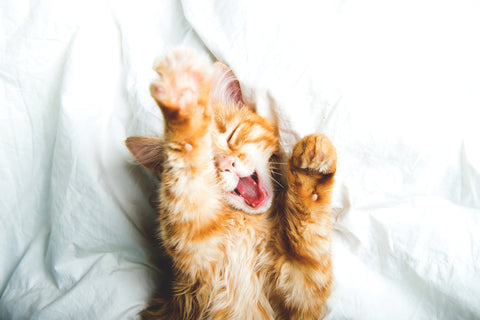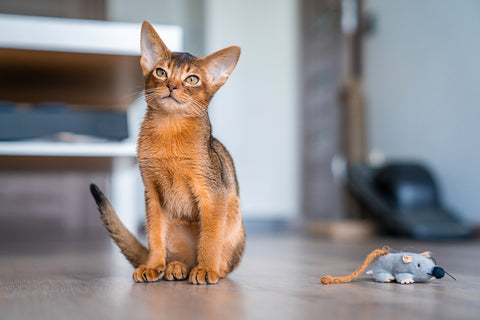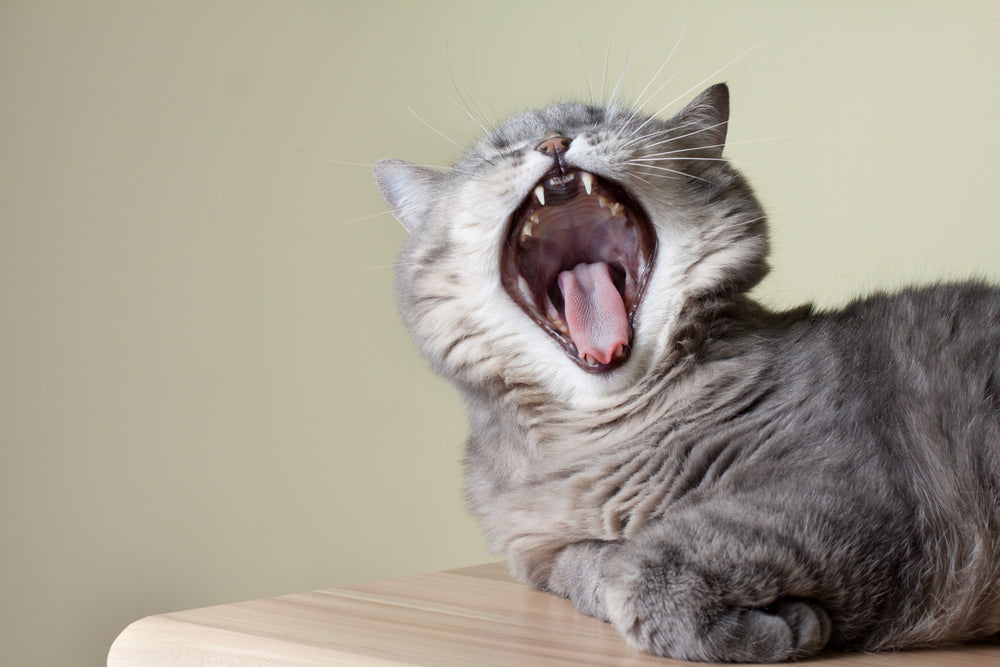
How to best care for your cat's teeth and support their oral health can feel like a complicated subject, but it doesn’t have to be! It’s an important topic to discuss, since your cat’s oral health directly impacts their overall health and well-being. Today, we’ll discuss your cat’s teeth and growth timelines, dental conditions to be aware of, and how you can provide your beloved cat with the best oral health care possible!
How Many Teeth Do Kittens Have?
Did you know that kittens are born without teeth? First, they’ll grow baby teeth, similar to how we do, but the growth timeline is more accelerated than it is in humans. Their set of baby teeth includes 26 teeth: 12 incisors, four canines, and 10 premolars. These will naturally fall out over time before and as their adult teeth begin to emerge.
Teething Timeline
Kittens teeth begin to emerge around 2-4 weeks old By weeks 6-8, they should have their full set of fully grown baby teeth, also known as “milk” or “deciduous” teeth or more scientifically as “primary” teeth.

When your kitten is between 3-6 months of age, you may notice that they are more prone to chewing—whether on toys or anything else in sight. This is the start of the teething process when your kitten is trying to loosen baby teeth to make space for permanent adult teeth to grow. During this process, you may find some of their baby teeth around in the house. You needn’t be alarmed, as this is completely normal. It’s unlikely that you’ll find all 26 of your kitten’s baby teeth, since some of the teeth are naturally swallowed.
How Many Teeth Do Adult Cats Have?
After the teething process is finished, your cat should have 30 permanent adult teeth. All permanent adult teeth typically emerge by around 6-7 months of age. This will include 12 incisors, four canines, 10 premolars, and four molars.
Types of Cat Teeth
Cat teeth are designed with specific functionality. As carnivores, or meat-eaters, cats have razor-sharp teeth in the front of their mouth for tearing into prey and jagged to flat-surfaced teeth toward the middle and back of their mouth for transforming food into smaller pieces for chewing and grinding. There are four different types of cat teeth: incisors, canines, premolars, and molars. It’s helpful to know what each looks like and the role that they play.
Incisors
When you look into your fur baby’s mouth, you will see tiny teeth in front. There are six in the upper part and six in the lower, for a total of 12 incisors. Their primary function is nibbling and gripping, such as while grazing on grass or during grooming to remove dirt or pull fleas from the fur.
Canines
After you have located the incisor teeth, right behind them are four bigger fang-looking teeth called canines (two on top, two on bottom). Canine teeth are strong and very sharp, and your cat’s powerful bite helps them use their canines to kill and hold onto prey or other food and start to tear it into smaller pieces. These sharp teeth emerge around 5 months of age, and can often be seen peeking out of a sleeping cat’s relaxed mouth.
Premolars
With their sharp, jagged edges, you can identify your cat’s premolars just behind the canines. These teeth have the job of chewing and breaking food down into even smaller pieces. There are six premolars on their upper jaw and four on their lower jaw, for a total of 10 premolars. These teeth typically erupt around 4-6 months of age.
Molars
Arriving around 4-5 months of age, molars will come in as part of your cat’s set of adult teeth. Molars are located farthest from the front of your cat’s mouth. There are four molars, two upper and two lower located on the left and right sides of the mouth. Molars are important for chewing, grinding, and crushing, especially bone and other food with a harder consistency.
Common Dental Conditions In Cats
Just like for humans, oral health is very important for cats. Unfortunately, most dental conditions often go unnoticed in cats until later stages, by which time they are in pain and treatment options are more limited. This is because it can be very difficult to detect dental disease in cats with the naked eye, since most dental disease is below the gum line. Cats are also notorious for hiding pain, whether it’s in their mouth or somewhere else. It’s simply in their nature, because they instinctively want to appear strong in the eyes of potential predators, and this instinct has remained strong—even for the domesticated house cat that never goes outside.
The three most common dental issues that affect cats are gingivitis, periodontal disease, and tooth resorption. Bad breath, also known as halitosis, is another condition that affects many cats and can be an indicator of an emerging or current dental disease. Learn more about how to identify the top 10 signs of dental disease earlier so that you can help protect your cat from unnecessary pain and discomfort.

Gingivitis is an early stage of gum inflammation, caused by plaque and tartar buildup under the gum line. Signs include red, swollen gums that are painful to the touch. If left untreated, gingivitis can progress into an advanced stage of gum inflammation called periodontitis, which results in destruction of the support structures that hold the teeth. Periodontitis and gingivitis both fall under the umbrella term of periodontal disease.
If plaque and tartar are not removed with a proper dental cleaning by your veterinarian, accumulation will continue and progress into periodontitis. Tooth loss will eventually occur, and in the final stages, plaque microbes can reach the bloodstream and cause potentially irreversible damage to the kidneys, heart, and other organs.
Tooth resorption is a dental condition that progressively degrades tooth structures, leading to irreversible tooth damage. The resorption process typically begins with erosion of the enamel along the gums and advances towards the center of the tooth into dentin. As resorption progresses, more and more of the tooth may be damaged. The premolars and molars are known to be most affected by resorptive lesions.
How To Keep Your Cat’s Teeth Healthy
Taking care of your cat’s oral health is an important step toward helping them live their very best life. Let’s review some of the ways that you can keep your kitty’s smile shining bright to support their overall health for many years to come!
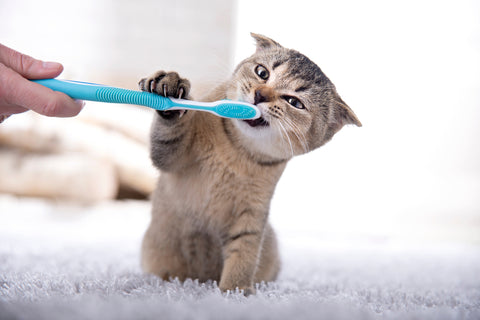
Brushing Teeth
At-home tooth brushing is key to keeping dental disease away by preventing the buildup of plaque and tartar. When in doubt, ask your vet to show you how to clean your cat’s teeth properly and don’t forget to keep our step-by-step guide to brushing your cat’s teeth on hand.
Healthy Diet

The Veterinary Oral Health Council (VOHC) provides a list of accepted products for cats that support their oral health. This list includes dietary recommendations, treats that support dental health, and other water or food additives and topical products for supporting a healthier mouth. Always consult with your veterinarian about proper nutritional and caloric needs for your cat; every cat is unique, so there is no one-size-fits-all diet (especially for cats with underlying health conditions).
Regular Check-Ups and Dental Cleanings
Bringing your cat to the veterinarian for regular wellness and oral health checks is an essential part of a successful oral health strategy. The American Association of Feline Practitioners (AAFP) provides helpful resources on the importance of feline oral health examinations, including questions to consider asking your vet, and the basics of feline anesthesia, which keeps your cat safe and pain-free during oral health procedures and allows the vet to thoroughly examine your cat’s mouth and effectively perform a cleaning.
Conclusion
Knowing more about your cat’s teeth is an important part of supporting their oral health. Just like we have to brush our teeth everyday to prevent dental disease, cats also need to have their teeth cared for on a daily basis to protect their oral health. Read the Basepaws guide through feline dental care to learn more about establishing an at-home routine. Visit this link to the Veterinary Oral Health Council (VOHC) list of recommended products that can support your cat’s at-home oral care routine, which can help you proactively support your cat’s oral health. When an oral health condition is caught early enough, it means that there are more options to treat it so that its progression can be slowed, and oftentimes reversed.

Support Your Cat's Oral Health with Basepaws
The Basepaws Oral Health Test For Cats is a one-of-a-kind screening tool that tells you if there are signs of active dental disease in your cat. The state of your cat’s oral health changes just like yours does, and these changes can be influenced by brushing habits, diet, and even genetics. Your cat’s mouth holds valuable information about their risk for having–at the time of testing–any of the three most common dental conditions: bad breath (halitosis), tooth resorption, and periodontal disease. The sooner you know, the sooner you can take charge and address issues, both through a more effective at home routine and with regular dental cleanings at the vet. Being proactive about your cat’s oral health can help you keep surprises to a minimum and, most importantly, keep your cat from experiencing unnecessary discomfort and pain.

